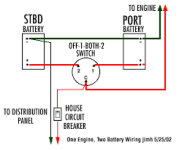capt. meares
New member
While recently overnighting on the bay at anchor, I realized there was a potential of possibly wearing down my battery, losing power leaving me stranded in the bay. I currently have just one (1) battery. I will list all the items that this battery was running to paint the picture clearly for my question....
1) two house lights (all bulbs throughout boat are LED) used for3 hours.
2) Navigation lights (LED) left on all night.
3) Lowrance GPS Elite 5 (left on all night for anchor alarm)
4) Anchor light (LED) left on all night.
While not using the boat, my single battery is ALWAYS plugged into a battery tender.
Question #1. Can I continue to get by with just one battery with this being a typical night of usage? I am a big fan of keeping everything simple as a C-dory is meant to be.
Question #2. If the answer is NO to question #1, would it be acceptable to always bring a fully charged jump pack as an alternative to adding a second battery?
I never plan on needing a microwave, hair dryer, satellite TV etc. Again, I like to keep it simple.
Thanks
1) two house lights (all bulbs throughout boat are LED) used for3 hours.
2) Navigation lights (LED) left on all night.
3) Lowrance GPS Elite 5 (left on all night for anchor alarm)
4) Anchor light (LED) left on all night.
While not using the boat, my single battery is ALWAYS plugged into a battery tender.
Question #1. Can I continue to get by with just one battery with this being a typical night of usage? I am a big fan of keeping everything simple as a C-dory is meant to be.
Question #2. If the answer is NO to question #1, would it be acceptable to always bring a fully charged jump pack as an alternative to adding a second battery?
I never plan on needing a microwave, hair dryer, satellite TV etc. Again, I like to keep it simple.
Thanks

